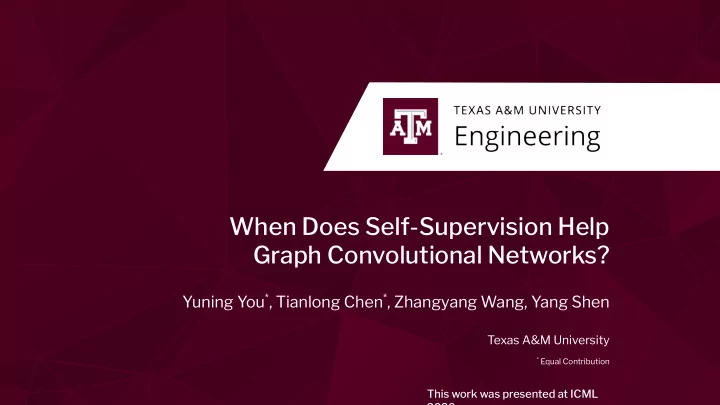

When Does Self-Supervision Help Graph Convolutional Networks? Yuning You * , Tianlong Chen * , Zhangyang Wang, Yang Shen Texas A&M University * Equal Contribution Department of Electrical and Computer Engineering 1 This work was presented at ICML 2020
Contents Motivation • Contribution 1. How to incorporate self-supervision (SS) in graph • convolutional networks (GCNs)? Contribution 2. How to design SS tasks to improve model • generalizability? Contribution 3. Does SS boost model robustness? • Conclusions • Department of Electrical and Computer Engineering 2
Motivation Semi-supervised (SS) learning is an important field of • graph-based applications with abundant unlabeled data available; Using unlabeled data, SS is a promising technique in the few-shot • scenario for computer vision; SS in graph neural networks for graph-structured data is still • under-explored with an exception (M3S, AAAI’19). Department of Electrical and Computer Engineering 3
Contribution 1. How to incorporate SS in GCNs? We perform a systematic study on SS + GCNs: • – 1. How to incorporate SS in GCNs? Train Train in the with SS downstream tasks task • Pretraining & finetuning; Generate pseudo Train in the labels via SS downstream treated as true task • Self-training (M3S, AAAI’19); labels Repeat several rounds • Multi-task learning. Train in the downstream task together with SS tasks Department of Electrical and Computer Engineering 4
Contribution 1. How to incorporate SS in GCNs? Multi-task learning: Train in the downstream • task together with SS tasks – Empirically outperforms other two schemes; – We regard the SS task as a regularization term throughout the network training; – Act as a data-driven regularizer. Department of Electrical and Computer Engineering 5
Contribution 2. How to design SS tasks to improve generalizability? We investigate three SS tasks: • We illustrate that different SS tasks benefit generalizability in different • cases. Department of Electrical and Computer Engineering 6
Contribution 3. Does SS boost robustness? We generalize SS into adversarial training: • – Adversarial training: – SS + Adversarial training: Department of Electrical and Computer Engineering 7
Contribution 3. Does SS boost robustness? We show that SS also improves GCN robustness without requiring • larger models or additional data. – Clu is more effective against feature attacks; – Par is more effective against links attacks; – Strikingly, Comp significantly boosts robustness against link attacks and link & feature attacks on Cora. Department of Electrical and Computer Engineering 8
Conclusion We demonstrate the effectiveness of incorporating • self-supervised learning in GCNs through multi-task learning; We illustrate that appropriately designed multi-task • self-supervision tasks benefit GCN generalizability in different cases; We show that multi-task self-supervision also improves • robustness against attacks, without requiring larger models or additional data. Department of Electrical and Computer Engineering 9
Thank you for listening. Paper: https://arxiv.org/abs/2006.09136 Code: https://github.com/Shen-Lab/SS-GCNs Department of Electrical and Computer Engineering 10
Recommend
More recommend